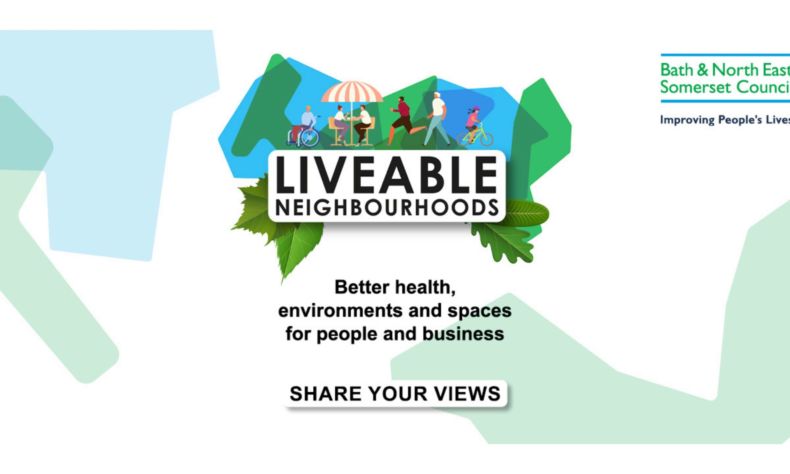Three new schemes designed to improve residential neighbourhoods will be launched this month as trials under Bath & North East Somerset’s community-led Liveable Neighbourhoods programme.
The schemes will see through-traffic restrictions operating in Church Street, Bath, Southlands in Weston, and Queen Charlton Lane near Whitchurch village from Thursday 17 November for a minimum of six months.
The aim is to reduce the dominance of vehicles in neighbourhoods without restricting vehicle access to homes and businesses, and to create a safer, healthier environment for walking, cycling, and playing outside.
Modal filters will be placed in the roads, which will be drop-down bollards or temporary ornamental planters that allow pedestrians, cyclists, people with pushchairs, and those driving mobility scooters to pass through, but not unauthorised vehicles.
Access will not be restricted for the emergency and other key services, and residents and their visitors will still be able to drive to their homes. Some residents may need to take alternative routes.
The trials are the first in a series of improvements due to be delivered under the community-led Liveable Neighbourhood programme and have been brought forward by ward councillors on behalf of residents who have voiced concerns about through-traffic and anti-social driving in their area.
Letters are being sent to residents in each area to let them know about the start of the Experimental Traffic Regulation Orders (ETROs) which follows extensive engagement on the schemes.
The six-month trial gives people the chance to experience the through-traffic restriction in practice and submit their feedback before a final decision is made about whether to make them permanent.
All three schemes can be implemented from 17 November, but work will not start to install the changes to the road layout until the week beginning 28 November, taking two to three days to complete. Advance signage will also be installed.
In Southlands a set of temporary, wooden planters will be placed on the road outside nos. 126 and 128 Southlands and double yellow lines will be provided on either side to create space for turning vehicles. Access to Southlands is from either Penn Hill Road or the High Street, and vehicles must exit using the same route. Emergency and other key services have been made aware of these access routes. Full details are also available at www.bathnes.gov.uk/southlandsetro
In Queen Charlton Lane, a traffic-free area will be created by installing two sets of droppable bollards and temporary wooden planters. One set will be located just after Furthermead Farm, as you drive from the A37/Whitchurch village. The other will be located after Dapwell Lane as you drive from Queen Charlton. The emergency services and landowners/farmers are able to drop the bollards to gain access. In front of both sets of bollards there is space for vehicles to turn. It is anticipated that motorists will instead use Woollard Lane and Highwall Lane. Full details are also available at www.bathnes.gov.uk/queencharltonlaneetro
Church Street will see a set of drop-down bollards located on either side of the church and Widcombe Manor. Vehicle access is available from either end of the lane via Ralph Allen Drive and Widcombe Hill, with space provided in front of each set of bollards for vehicles to turn and exit using the same route. New double yellow lines will be provided in front of Widcombe Manor to ensure turning space. Church Lane is accessible from Widcombe Hill. Authorised persons, including church leaders and the emergency services, will be able to drop the bollards to gain access when required. Full details are available at www.bathnes.gov.uk/churchstreetetro
Councillor Sarah Warren, deputy leader and cabinet member for Climate and Sustainable Travel, said:

The aim of the schemes is to make roads and residential neighbourhoods safer and healthier spaces for people to walk, wheel or cycle around.
We’ve undertaken a great deal of engagement with residents as part of our Liveable Neighbourhoods programme and I’d like to thank everyone who has taken part for their contributions.
These schemes are going in as Experimental Traffic Regulation Orders which means people can still comment on them for the duration of the trial before a final decision is made later next year.
The Liveable Neighbourhood programme is encouraging residents in 15 areas across B&NES to re-think how public space can be used in order to reduce the dominance of motor vehicles, creating healthier outdoor spaces for everyone to share, as well as vibrant local high streets where people want to spend time and money.
Working collaboratively with the council, residents of these areas are putting forward a range of measures to be considered, including vehicle restrictions, safer crossings, wider pavements, improved seating and public space. The aim is to improve people’s well-being, reduce social isolation, and provide a cleaner, safer environment for everyone to enjoy. Further details can be found at www.bathnes.gov.uk/yourLN
To find out more about the trial measures being introduced on these three residential streets, please visit www.bathnes.gov.uk/LNPilots
